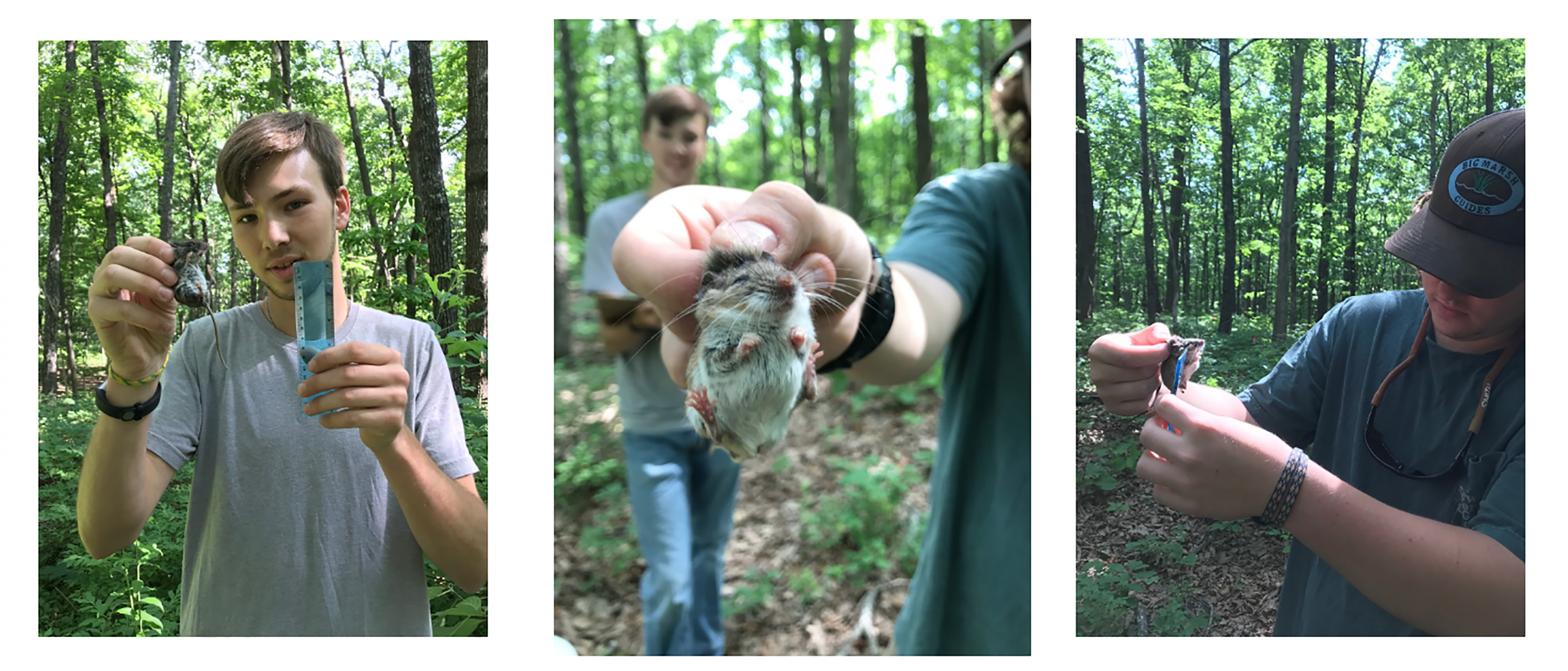
This summer, we—Cole Johnson (pictured left) and Eli Walker (pictured right)—had the privilege to work for Dr. Amy Turner and Dr. Ken Smith in the Office of Environmental Stewardship and Sustainability. Over the course of the summer, we worked on several field projects related to the overall health of the Domain. We began our summer by taking the chainsaw safety certification course so that, if needed, we could effectively and safely make use of a chainsaw to limb, buck, and fell trees. After the course we began five weeks of small mammal trapping using baited Sherman mammal traps. We trapped for a total of five weeks, and each week we sampled at three individual sites representing different forest types, and set out a grid of forty-eight traps at each location. Every morning after setting the traps, we checked them for any captures that occurred. We did this so that any mice caught would not overheat in the small Sherman traps. We really enjoyed the small mammal trapping because it afforded us the opportunity to spend time outdoors—no matter what the weather conditions were like that day.
In addition to the small mammal trapping, we also worked with Dr. Kristen Cecala, who wanted to know more about the salamander abundance and diversity of two unnamed streams off Roarks Cove. Over the summer, we surveyed each of these streams a total of six times for salamander activity. Surveying consisted of starting at the most downstream point and working our way upstream flipping rocks and netting for salamanders. Additionally, we spent several evenings of our time at the constructed wetlands assisting Dr. Scott Torreano and Dr. Deborah McGrath in removing invasive plant species, including duckweed and cattail. This was important work because these species were outcompeting the planted vegetation in the basins and restricting native plant growth. These evenings may not have been very desirable for many college students, but with a couple sets of waders and nets, we and other summer workers went in with our boots and nets, ready to get the job done. Also, we assisted Dr. Ken Smith with the removal of invasive tree species such as Tree of Heaven in several forest restoration research sites.
This summer, the Office of Environmental Stewardship and Sustainability partnered with TWRA (Tennessee Wildlife Resource Agency) on a bear research initiative. This consisted of setting 4 baited hair snares in the Sewanee area. The hair snares were a configuration of two strands of wire placed around three trees at knee and waist height, forming a triangle. A jelly donut along with a preserve concentrate, that was sprayed on an absorbent material, was hung in the middle of the triangle as the lure for any potential bear. If a bear was interested in the bait, it would have to cross over the wire, leaving samples of its hair for us to come back at a later time for collection and DNA analysis. Unfortunately, no black bear hair was collected this summer.
We also conducted a turtle survey for the month of July. For the past few years Dr. Cecala has trapped for turtles in ponds with vastly different habitat characteristics. We set ten hoop traps at Farm Pond, located in the equestrian pasture, and ten hoop traps in the SUD lagoon. Our efforts turned up mostly snapping turtles and sliders at both locations. Once caught, each turtle was measured, weighed and received an individual code by marking the outer ring of its shell.
The last week of our assistantship revolved around the Southeastern Bat Diversity Network- Bat Blitz. Sewanee hosted roughly 90 bat professionals and volunteers for a week of mist netting at night. Mist netting is a term referring to a very fine diameter mesh used to capture animals like bats and birds. Throughout the week, groups netted at sites that had been scouted and predetermined during the summer. Several different species of bats were caught throughout the week including: Big brown bats, evening bats, Gray bats, and a hoary bat. Some of the sites we personally visited included the Big Sink in Lost Cove, Buggy Top in Lost Cove, the Elk River, and other points of interest on the Domain. This was an amazing experience for both of us as we were able to participate in a day in the life of a field biologist. The bat blitz also enabled us to meet and connect with some very experienced and friendly professionals.
Overall, this summer was an adventure every day, and the experiences we have gained from them are irreplaceable. We could not have asked for a better summer, and we are very grateful for the opportunity to work in a place as unique as Sewanee and under our great supervisor, Dr. Amy Turner.

